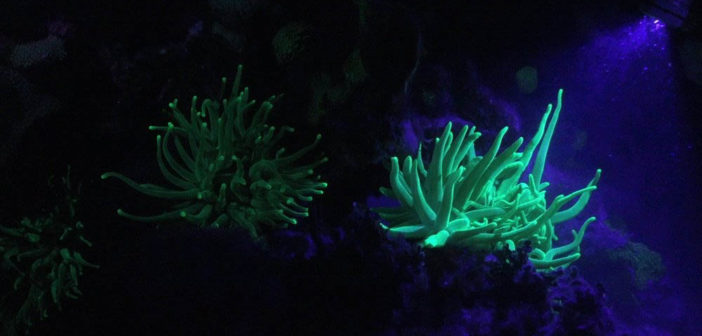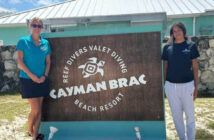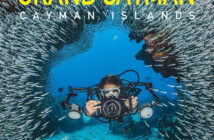Wrecks, walls, shore dives, moonlight dives, fluorescent night dives, coral spawning – all add to the quality of the Cayman “dive experience”
Blessed with 365 dive sites, warm clear water and great weather year-round, the Cayman Islands consistently rank among the best dive destinations in the Caribbean. Famous for its variety of daytime dive experiences – dramatic drop-offs, coral gardens, spectacular shipwrecks, easy shore diving and Stingray City – local dive operators want to point out that the same dive sites undergo a magical transformation at night, and that is worth exploring too. The reefs and wrecks in Cayman become hubs of activity when the sun goes down because lobsters, moray eels, crabs, shrimp and other nocturnal critters come out to hunt for food. Night divers watch the action by focusing on the narrow beam of their dive light. Local dive operators offer a range of night dive experiences by boat and shore diving, plus extra special events.
Boat Night Dives
“The Kittiwake is a great dive during the day, but divers should see the wreck at night when it takes on a whole new life as the critters who live there now come out of their hiding places in the nooks and crannies of the wreck looking for food,” said Jo Mikutowicz owner of Divetech. “There is also a lot of action on the adjacent reef too, as sea creatures there are on the prowl.”
A favorite boat night dive for Sunset Divers is the Wreck of the Balboa located in George Town Harbour, which is difficult to dive during the day because of general harbor traffic.
“The Balboa is a shallow wreck that becomes a hive of activity when darkness falls – it’s almost a ‘guarantee’ that night divers will find an octopus exploring the wreck,” said Sunset House’s Emma-Jane Fisher. “The sand flat between the wreck and the reef is also very interesting because it has an algae patch where nudibranchs are often found.”
Neil van Niekerk, of the Southern Cross Club, says night dives in Little Cayman are special because conditions must be ideal to navigate the channel. “On those nights when we make a night dive, exploring Bloody Bay Marine Park in the dark is an amazing adventure,” he said. “Vertical walls drop off dramatically into the black night, which is exhilarating to see. We see night time creatures such as Basket Starfish and Octopus, and also groupers hunting in the beams of our flashlights.”
Ocean Frontiers at East End has added a 1-tank “Glow” Night Dive to its dive schedule in keeping with latest trend in night diving, Ultraviolet dive lights. Co-owner Steve Broadbelt says UV lights allow divers to see corals and critters fluoresce in bright glowing neon colors.
“Unique to Sunset Reef at East End are the hundreds of Pink Tipped anemones found at the site,” he said. “Anemones are packed with fluorescent proteins that glow when excited by the underwater blacklights. Even the most seasoned diver will end a glow dive will the realization that they had not ‘seen it all.’ This magical experience is a must-see for all scuba divers who love the sea.”
Shore Night Dives
Grand Cayman’s excellent shore diving is well known, and these dive sites make amazing and easy night dives. Sunset House, with easy entry and exit to its shallow reefs, offers unlimited shore diving in its dive packages. Guests can also book a guided night dive.
“Night divers can start in the resort’s sea pool to search for our resident squadron of squid,” said Emma-Jane Fisher (Sales & Marketing, Sunset House). “They can then make their way to the reef’s mini wall, where our Mermaid statue stands guard, and where octopus and the elusive Slipper lobster can often be spotted. We’re lucky to have such a bountiful reef right in front of Sunset House.’
Lighthouse Point also offers great shore night diving with easy entry and exit to the mini-wall located just offshore. The pier is another great spot for night dives, and Divetech also offers guided night dives from shore on Mondays and Thursdays.
“During our regular night dive, we like to pull out our ‘blue light’ for ‘fluro’ effect to show our divers how the reef lights up under an ultraviolet light,” said Jo Mikutowicz. “The colorful corals we see during the day show another side at night with spectacular fluorescent colors, like neon pink, yellow, green and more.”
Coral Spawning Night Dive
With every September comes the opportunity to experience a unique night dive as coral spawns simultaneously across the island. Ocean Frontiers has successfully calculated the spawning time, so the operation offers special night dives for the event.
Full Moon Night Dive
Venturing out on a night dive during a full moon can also be a fantastic experience because of Cayman’s incredible visibility. With the full moon clearly visible overhead, the dive site never gets completely dark, comforting to new divers. Experienced divers can swim the shadows of the reef in the moonlight exploring a new landscape – and see the “other-worldly” light beams of other night divers on the reef. Night divers also enjoy bioluminescence suspended in the water. They dim their dive lights, wave their hands about to see plankton sparking like fire embers.
Night Dive Specialty Course
Novice divers unsure about making a night dive can sign up for a PADI Night Diver Specialty Course where they learn how to focus on what to look for in their light’s beam, how to control buoyancy by feel and how to pay attention to details overlooked during a day dive.
“The Specialty Course consists of three-night dives – two boat dives and one shore dive,” said Red Sail Sports Dive Manager Clive Webb. “We explain that the daytime fish are mostly hiding at night, and the nocturnal creatures are out and about. There are so many different creatures at night, we could fill pages. We can also have some fun on night dives. For example, we like to create a ‘fireworks display’ by gently fanning water across a Barrel Sponge. The sponge acts as a giant filter passing water through the outer surface causing silt to attach to the outside. If a diver covers up their light, and fans the silt away from the sponge, it creates a bioluminescence ‘sparks’ display in the dark – very cool.”
About Us
The Cayman Bottom Times is news collaboration by five leading dive operators to promote the superb diving of the Cayman Islands, and keep the diving public informed of important developments and events. Divetech, Ocean Frontiers, Red Sail Sports and Sunset House in Grand Cayman, and the Southern Cross Club in Little Cayman, all members of the Cayman Islands Tourism Association, represent more than 100 years of solid experience in a destination that is recognized as the birthplace of recreational diving. With a unique combination of deep wall and shallow reef diving, several wrecks, and world-famous Stingray City, the Cayman Islands has cemented its place as the top diving destination in the Caribbean.
Offering diverse and wide-ranging dive programs on both Grand Cayman and Little Cayman, the members of this dive group represent the best Cayman has to offer; Divetech, Ocean Frontiers, Red Sail Sports Grand Cayman, Sunset House and the Southern Cross Club.









